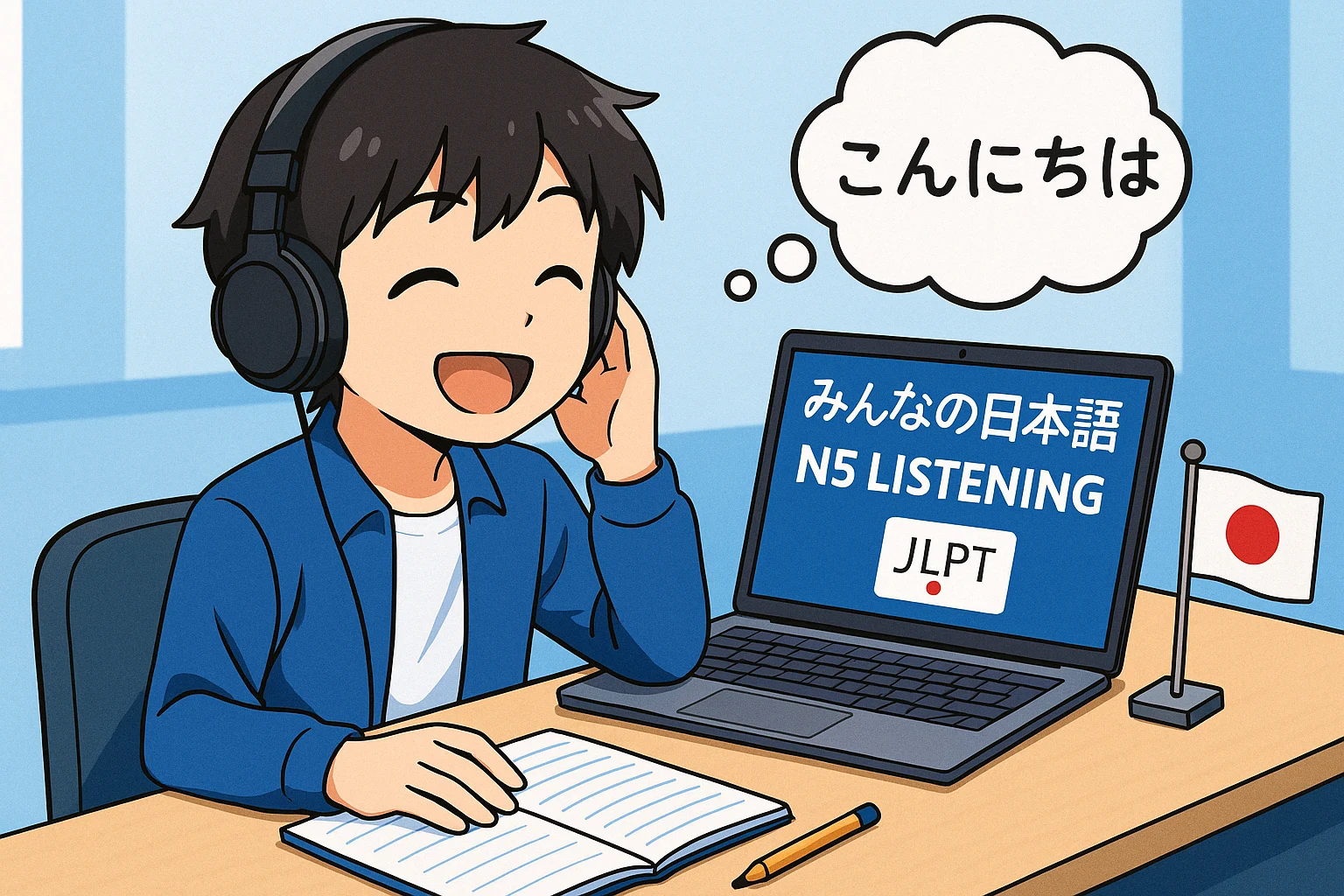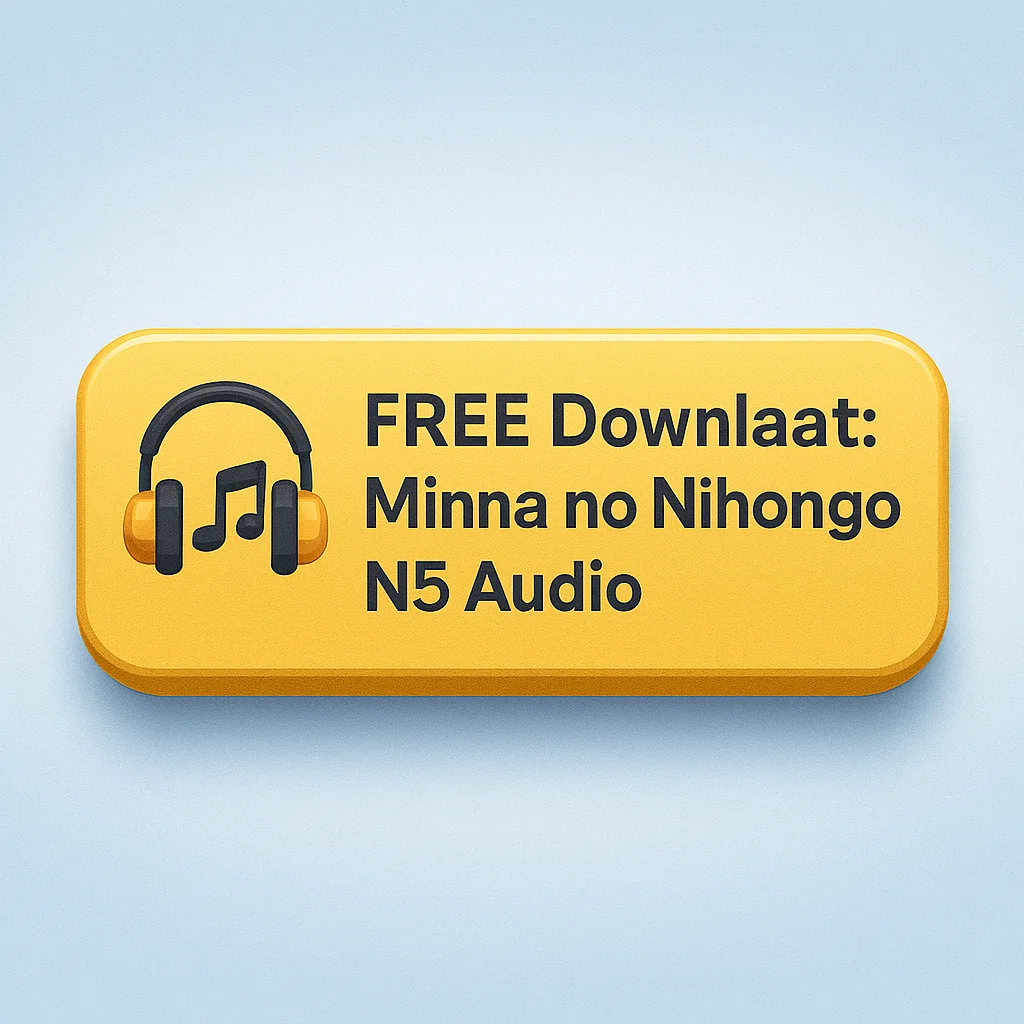Are you preparing for the JLPT N5 but struggling with the listening section? Many learners find Japanese listening challenging due to fast speech and unfamiliar accents. But here’s the good news: Minna no Nihongo’s N5 listening exercises are one of the best ways to train your ears!
In this guide, you’ll get:
✅ Free downloadable audio for Minna no Nihongo N5 listening.
✅ Proven strategies to improve comprehension.
✅ JLPT N5 exam tips to boost your score.
If you translate Kanji to Hiragana, click here

Read More: Minna no Nihongo Lesson 1 Vocabulary and Grammar
Minna no Nihongo N5 Listening 1 to 25.
Why Minna no Nihongo N5 Listening is Essential
The JLPT N5 listening section tests your ability to understand basic conversations. Minna no Nihongo is trusted by beginners because
✔ Natural dialogues—mimics real-life Japanese.
✔ Clear pronunciation – Helps distinguish sounds like “tsu” vs. “su.”
✔ Structured difficulty—Starts easy and gradually gets harder.
📌 Pro Tip: Pair this with our Minna no Nihongo N5 Vocabulary List for better retention!
Read More: Why Is My Japanese Keyboard Not Working on iPhone?

Minna no Nihongo N5 Listening App
The Minna no Nihongo N5 Listening App is a helpful tool for beginners learning Japanese, especially those using the Minna no Nihongo textbook series. It provides audio practice for vocabulary, grammar, hiragana, katakana, and conversation from the N5 level, helping users improve their listening skills through real Japanese pronunciation and context-based examples. Ideal for self-study or classroom support, the app is available on Android devices. Download it from the Google Play Store.
1. Minna no Nihongo lessons 1 to 25 PDF Free download
🔗 Click Here to Download Minna no Nihongo N5 Listening App MP3s (Free!)
2. Active Listening Techniques
-
Shadowing: Repeat sentences immediately after hearing them.
-
Dictation: Write down what you hear, then check the script.
-
Quiz Yourself: Cover the answers and test your understanding.
3. Common Mistakes to Avoid
❌ Passive listening (just playing audio in the background).
❌ Skipping repetition (practice each dialogue 3+ times).
❌ Ignoring unknown words (note them down and review later).
📌 Need grammar help? Check out our JLPT N5 Grammar Guide.
JLPT N5 Listening Exam Tips
The actual test has 3 question types:
-
Picture-based questions (choose the correct image).
-
Response selection (pick the best reply).
-
Conversation comprehension (answer questions about a dialogue).
How to Prepare:
-
Simulate exam conditions (use a timer, no pauses).
-
Focus on question words (e.g., doko, dare, nani).
-
Practice with mock tests (we recommend the JLPT Official Practice Workbook).

🎯 Ready to ace the JLPT N5 listening section?
-
Download your free Minna no Nihongo audio above.
-
Practice daily using our tips.
-
Please leave a comment if you have any questions.
Share this post with fellow learners! 👇
Here IS THE ULTIMATE GUIDE TO HIRAGANA: LEARN IT!
Minna no Nihongo N5 Listening PDF
A wide range of Japanese audio resources, including podcasts, audiobooks, and web videos, should be listened to to learn the language effectively. This will expose you to a variety of accents, speeds, and settings.
You learn hiragana and katakana first. Some applications are designed specifically to enhance listening abilities, and these apps are used for language acquisition. Pimsleur, Rosetta Stone, and FluentU are a few examples of apps that are very popular.
Read More: Minna no Nihongo Lesson 4 Vocabulary
Books for JLPT Listening Practice: Some books are specifically designed to help students improve their listening skills for the JLPT. The majority of the time, these books come with CDs or online resources that offer listening exercises of varying degrees of difficulty, including N5.
Exchange of Languages: Participate in a language exchange with people who are native Japanese speakers. This gives you the chance to hone your listening skills by participating in actual social interactions.
Watch Japanese Television Series and Movies: If you want to enhance your listening abilities, watching Japanese television series and movies with subtitles might be a good way to do so. Be sure to pay attention to the way native speakers pronounce words and phrases.
Shadowing and Repeating: To improve your pronunciation and intonation, you should practice repeating sentences and phrases after native speakers. This technique, known as shadowing, enhances your listening and speaking skills simultaneously.
When you are practicing, it is important to remember to be consistent, and as you become more acquainted with the materials, progressively increase their complexity. Additionally, to have a well-rounded experience while learning a language, it is vital to mix listening practice with other language abilities such as reading, speaking, and writing.
N5 Minna no Nihongo Listening
If you’re just starting your Japanese language journey, Minna no Nihongo N5 Listening is the perfect companion to boost your listening skills. Designed especially for beginners, this app follows the structure of the popular Minna no Nihongo textbook, making it easier to understand real-life conversations and sentence patterns. Each lesson includes clear, native Japanese audio that helps train your ears to natural pronunciation, rhythm, and vocabulary usage.
Conclusion
Mastering Minna No Nihongo N5 listening requires dedication and strategic practice. You can achieve this by utilizing the audio resources provided in the book, implementing effective techniques such as shadowing, and supplementing with additional materials. Start your journey today and immerse yourself in the beautiful language of Japanese!
FAQ Mastering Minna No Nihongo N5 listening
Can Minna No Nihongo alone prepare me for listening to JLPT N5?
While Minna No Nihongo provides an excellent foundation, it’s best to supplement it with practice tests and additional listening materials.
How much time should I dedicate each day to listening practice?
Dedicate at least 30 minutes to listening practice daily. Consistency is key to improvement.
Could you please advise on what steps to take if I am unable to comprehend the audio?
Don’t worry! Start by identifying familiar words, then gradually build your comprehension. Use the transcript to guide your learning.
Is it okay to rely on subtitles while practicing?
Initially, subtitles can help but try to wean off them as you improve. Listening without visual aids develops stronger skills.